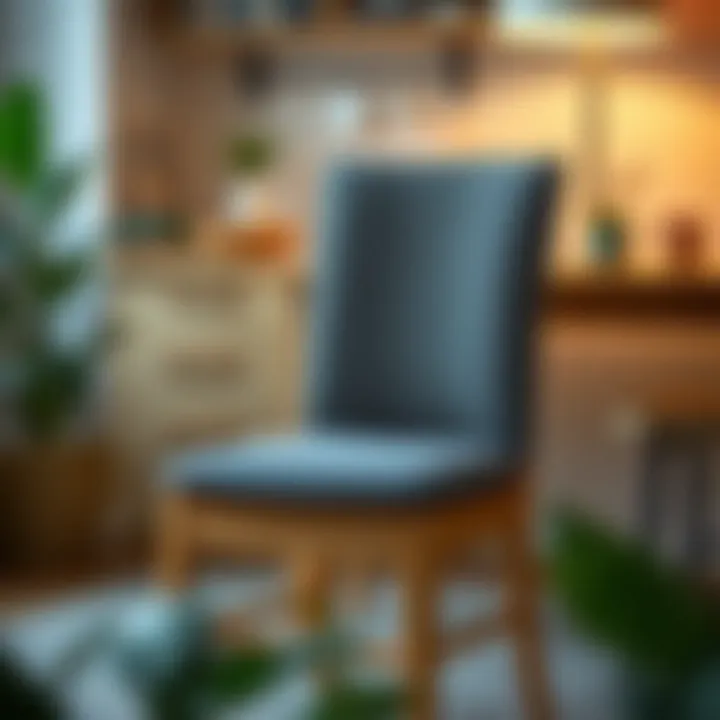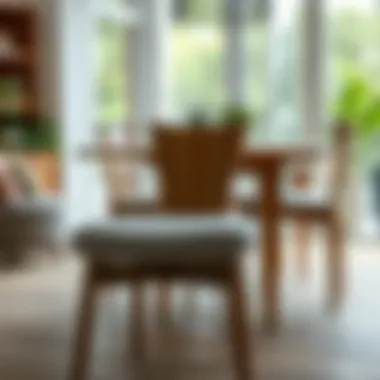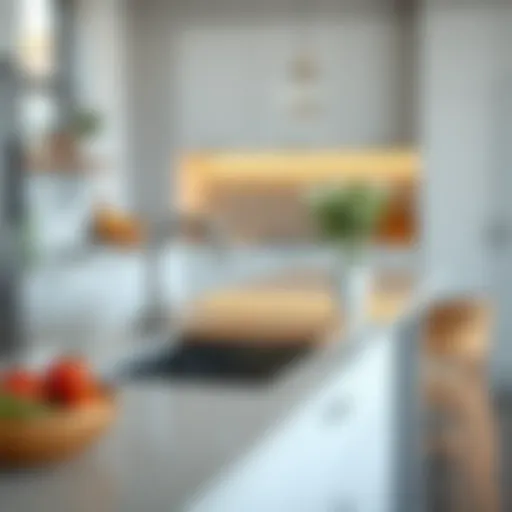Replacement Seat Pads for Dining Chairs: Your Guide


Intro
Creating a welcoming dining space can often hinge on the comfort and style of your seating arrangements. One of the more accessible yet impactful ways to enhance this experience is through the incorporation of replacement seat pads. These pads go beyond mere aesthetics—they play a critical role in comfort, ergonomic support, and longevity of your chairs. Understanding the nuances of replacement seat pads can dramatically elevate your dining experience.
In this guide, we will dive into key topics such as material choices, design preferences, and maintenance practices that can help you choose the right seat pad for your dining chairs. Whether you’re updating your kitchen table setting or sprucing up that dining room you love entertaining in, the right seat pads can truly make a difference. You might be surprised at the variety of options available, tailored to suit any style or requirement, so keep your eyes peeled for those little details.
Ultimately, at the end of this exploration, you’ll be equipped not just with knowledge, but with practical tips that can help you navigate the sometimes-overwhelming array of choices.
Furniture Design Trends
Current Trends in Furniture Design
When it comes to dining furniture, trends evolve just like fashion. In recent years, there has been a notable shift toward minimalism with clean lines and neutral colors. Perhaps you've noticed the rise in popularity of Scandinavian design—think functional yet stylish pieces that don’t overwhelm a room with excessive ornamentation.
Natural materials are making a strong comeback, too. Think about trendy options such as oak or walnut wood that can add warmth to any space. Likewise, eco-friendly fabrics—like organic cotton or recycled polyester—are gaining traction. These materials not only provide comfort but also resonate with the growing emphasis on sustainability in home decor.
Influential Designers to Follow
In the world of interior design, keeping an eye on the pioneers and trendsetters can be beneficial. For example, Marcel Wanders has created everything from classic to ultra-modern pieces that blend unique textiles with functionality. Another name to watch could be Kelly Wearstler, known for her bold mix of colors and textures which can inspire a homeowner to experiment with replacement seat pads that make a statement.
Maintaining an awareness of these designers can inspire not just choices in seat pads but also aid in creating an overall cohesive dining experience.
Practical Tips for Furniture Selection
Choosing the Right Materials
Selecting the right padding material is crucial—not just for comfort but also for durability. Foam is a commonly used material, offering a balance between softness and support. High-density foam is ideal for those seeking longevity. However, if you prefer a more plush feel, look into memory foam. It conforms to your body but can be a bit pricey.
You might also encounter down-filled pads which can give a luxurious feel but require regular fluffing and care.
Maximizing Space with Smart Furniture Choices
Sometimes, it’s not merely about comfort but also about how the furniture fits within your space. If your dining area is tight on room, consider slim profile seats or multifunctional pieces that serve more than one purpose. For instance, dining chairs with storage options beneath the seat pad can provide additional space for linens or seasonal decor.
Additionally, don’t overlook the versatility of slipcovers—they can easily change the vibe of your dining set without requiring a full replacement, and they often allow you to wash them, ensuring your dining area remains welcoming and fresh.
More details about utilizing space effectively can be found on sites like reddit.com/r/interiordesign or educational platforms such as *.edu.
Overall, knowing which fabrics, colors, and designs can resonate with your existing decor is key to making informed choices.
When evaluating your options for replacement seat pads, remember that it’s more than just filling a void; it’s about crafting an experience that harmonizes with your taste and enhances every meal shared around the table.
Prologue
When it comes to dining, the comfort of your seating can significantly elevate the entire experience. If a chair is hard or has seen better days, one might just as well be preparing for a one-way trip to discomfort city. Replacement seat pads play a crucial role in transforming a simple dining chair into an oasis of comfort. Looking deeper, one realizes that beyond mere aesthetics, these pads can enhance the overall atmosphere of a dining space.
In this comprehensive guide, attention is given to various aspects of replacement seat pads. We’ll cover materials you might consider, including how these choices can affect both comfort and durability. Another focal point is design, which marries form and function beautifully.
By the time you reach the end of this guide, you will have a firmer grasp on how to make educated decisions. This can turn your average dining experience into an enjoyable occasion whether it’s a family dinner or a formal gathering.
Purpose of Replacement Seat Pads
The main goal of replacement seat pads is multi-faceted. For starters, they offer immediate comfort. Think about the last time you sat at a dining table for an extended period. Chances are, you might have felt the rigidity of the chair biting into your backside. Well-designed seat pads can cushion that experience, making even the longest dinners a delight.
Secondly, the visual appeal of seat pads is undeniable. They can be used as a simple yet effective tool to refresh the entire decor of your dining area. With options available in a myriad of colors and patterns, you can easily enhance the ambiance without breaking the bank.
Lastly, by opting for quality replacement pads, you can contribute to the longevity of your existing dining chairs. Rather than investing in new furniture every few years, a well-selected seat pad can help extend the life and usability of your chairs. It’s affordability and style rolled into one.
Overview of Dining Chair Comfort
Understanding dining chair comfort goes beyond just how they feel at the moment of sitting down. It involves ergonomics, the right materials, and personal preferences. Specifically, the chair’s structure plays a vital role; a poorly designed chair can lead to discomfort and health problems over time. This is where seat pads become significant.
Most importantly, they can adapt to different body types. Each of us has unique needs, especially when it comes to how we sit. Some might prefer a firmer surface, while others relish a little give. The right seat pad takes these differences into account. Another consideration is the height and depth of the chair. The ideal seat pad will align well, keeping your posture in check and preventing fatigue during meals. If one were to say that comfort is subjective, they’d be right, but with the right materials and designs available today, there is a solution for nearly everyone.
In summary, seat pads are not just cushions; they are essential components contributing to the overall comfort of your dining experience. When thoughtfully chosen, they can make all the difference in creating a welcoming dining atmosphere.
"A comfortable chair can make or break a dining experience, and the right seat pad is key to that comfort."
As we delve into the subsequent sections, we will explore the materials, designs, and maintenance practices that elevate seat pads from mere accessories to indispensable elements of interior seating.
Material Considerations
When it comes to enhancing the comfort and functionality of dining chairs, the choice of materials can't be overlooked. Not only do they affect the aesthetic appeal, but they also significantly impact durability, comfort, and maintenance of the seat pads. Understanding different materials can guide your selections, helping you achieve both style and practicality in your dining space.
Fabric Options
Fabric choices can dramatically influence how a replacement seat pad performs and feels, as well as how it fits with existing decor.
Cotton
Cotton has been a staple in upholstery for generations. One of its key characteristics is breathability, making it ideal for prolonged seating. This material is soft to the touch and easy to dye, which offers the possibility of a vast array of colors to match any decor. While cotton is quite durable, it can be susceptible to wrinkling and staining without proper treatment. That said, it's a popular choice for its comfort and versatility. Furthermore, being a natural fiber, it contributes to a more eco-friendly choice.
Linen
Another natural option is linen. Known for its unique texture and natural luster, linen has a distinctive ability to look sophisticated. The fabric is highly breathable and becomes softer with use which adds to the comfort factor. However, it's essential to be aware that linen can be prone to wrinkling and may not offer the same level of stain resistance as synthetic fabrics. Still, its organic nature makes it appealing to those who prefer sustainable materials while providing an elegant touch to dining settings.


Polyester
Polyester, a synthetic fabric, boasts remarkable durability and resistance to wrinkles, fading, and stains. This makes it an ideal candidate for dining chair pads, especially in households where spills might occur. Its wide range of colors and textures allows for customizability, making it easy to fit various decor styles. On the flip side, polyester can sometimes feel less breathable compared to natural fibers, which might not be the best for every climate.
Leather
Leather lends a sense of opulence and sophistication to any dining chair. It's durable and easy to clean, making it a practical alternative for those who desire low-maintenance seat pads. Another key characteristic is its ability to develop a patina over time, which can add to its charm. However, real leather can be a bit pricier compared to other materials, and it might not be suitable for strict vegan or eco-conscious consumers, as its production does have more environmental impacts.
Foam Density and Types
The type of foam used in the seat pads largely dictates the feel and comfort level while dining. The foam's density can most directly influence the seat's longevity and comfort.
High-density foam
High-density foam is celebrated for its resilience and support. This density offers a firm seating experience, which can be beneficial for prolonged periods of use without sacrificing comfort. High-density foam holds its shape well, resisting flattening over time, essentially providing lasting returns on your investment. However, its firmer nature may not be for everyone, especially for those seeking a softer, cushier feel.
Memory foam
On the other hand, memory foam contours to the shape of the body, providing a customized seating experience. This responsiveness can relieve pressure points, making it a favorite for comfort-oriented designs. However, memory foam typically retains heat, which may not suit everyone's preference, especially during warmer months. It can also be more expensive than traditional foams.
Gel cushions
Gel cushions are another innovative option, combining layers of foam and gel to maximize comfort. They adapt well to body temperature and distribute weight more evenly, preventing discomfort during lengthy meals. Despite their advantages, gel cushions may be heavier and pricier than standard options, which might pose issues for some.
Wood and Natural Materials
For those seeking aesthetic charm alongside functionality, wood and natural materials offer unique benefits, marrying design with eco-consciousness.
Bamboo
Bamboo is a resilient and rapidly renewable resource, making it an eco-friendly choice for seat pads. Its natural aesthetic brings a warm and organic feel to dining spaces. Furthermore, bamboo has natural anti-bacterial properties which makes it easier to maintain cleanliness. However, its softer nature may not provide as much cushioning as foam options, requiring a careful balance between aesthetic and comfort.
Cork
Cork is another sustainable choice. It’s lightweight yet sturdy, providing enough support for comfort. Cork's natural texture adds an interesting visual element while also being moisture resistant, which can be advantageous for dining use. The downside, however, is that cork doesn’t have the same level of durability as some synthetic materials, potentially requiring more frequent replacements.
Reclaimed wood
Reclaimed wood brings a sense of history and character to any chair. Each piece carries its own story and charm, which can enhance a dining room's aesthetic. It also falls under the sustainable material category, giving it an eco-conscious edge. Yet, the finish and treatability of reclaimed wood can vary widely, and it might not offer the same level of comfort unless paired with appropriate cushioning.
By taking a closer look at these materials, homeowners and designers alike can make informed decisions that tie together comfort, aesthetics, and sustainability in their dining spaces.
Design Aspects
When it comes to replacement seat pads, design aspects play a pivotal role in both aesthetics and functionality. The visual appeal of your dining area can be significantly impacted by the choices made in this regard. Not only do these elements enhance the overall look of your dining chairs, but they also contribute to the comfort and functionality during meals. Therefore, understanding the nuances of design aspects can lead to a more satisfying dining experience.
Shape and Size Considerations
Square vs. Round
In the world of seat pads, the choice between square and round shapes is more than mere aesthetics. Square seat pads often provide a clean, modern look and typically fit snugly into chair corners, maximizing surface area. This characteristic makes them a popular choice for contemporary and minimalist settings, where symmetry plays a key role. On the other hand, round pads can lend a softer touch to the dining space, often deemed more inviting. They work well with chairs that have a more traditional or eclectic design. The unique aspect of round pads is that they can conform to the natural shape of the body, potentially offering a more comfortable experience.
Each shape carries its advantages and disadvantages. For instance, while square pads may offer a more tailored fit, they may not always suit round dining tables, creating a visual mismatch. Round pads, conversely, might be less stable on square chairs but promote a more casual atmosphere.
Thickness Variations
The thickness of seat pads is another crucial aspect, influencing both comfort and style. Thicker pads generally provide more cushioning, which can be a blessing for those spending extended hours at the dining table. This additional padding can lead to a more relaxed sitting experience, especially for individuals who find thinner pads uncomfortable. However, thicker can also mean bulkier, which might not align with certain aesthetic preferences.
A key characteristic of thickness variations is the ability to choose levels that match your needs. For instance, a thicker cushion might be perfect for a family gathering where everyone will be seated for dinner, while a slim option could be ideal for a minimalist breakfast nook. However, thicker pads can also affect the height of the chairs, which is an essential consideration to ensure that the dining experience is not compromised.
Color and Pattern Choices
Solid colors
The allure of solid colors in seat pads cannot be overstated. They offer a sense of simplicity and can easily blend with various interior styles. One of the central benefits of choosing solid colors is versatility; they can serve as a neutral backdrop, allowing other decor elements in the dining space to shine.
A unique feature of solid colors is their enduring appeal. Whether it’s a serene blue or a bold red, solid colors can evoke moods and complement the overall dining ambiance. However, the downside lies in their potential to be less eye-catching compared to patterned options, which might lead some to overlook the visual possibilities.
Patterns and textures
Patterns and textures can elevate seat pads from merely functional to striking focal points. Options range from whimsical florals to geometric designs, allowing individuals to express personality and flair. The main advantage of choosing patterned pads is their capability to hide stains better than solid colors, which can be crucial in households with young children or pets.
A significant trait of textured seat pads is the tactile experience they provide, making them more engaging to touch. On the flip side, overusing patterns can lead to visual clutter, particularly in small dining areas. Striking the right balance is essential to ensure the dining space remains inviting and coordinated.
Comfort and Ergonomics
When it comes to dining chairs, comfort and ergonomics play a pivotal role in how we engage with our living spaces. A seat pad might seem like a minor detail, but its influence on both physical well-being and the overall dining experience is significant. The essence of comfort in seating lies not just in cushioning but also in how that cushioning supports the body. Properly designed seat pads can alleviate pressure on the hips and lower back, leading to longer, more enjoyable meals spent with family and friends.
Assessing Comfort Level
To truly understand comfort, one has to consider a few key factors that contribute to the overall experience. Firstly, the right foam density can make or break your chair's comfort. For instance, high-density foam offers resilient support, stopping you from feeling like you’re sinking into the chair. Conversely, memory foam can conform to your body shape, providing a more customized feel. It's a balance between softness and support; too soft, and you may find yourself constantly shifting to get comfortable, but too firm may lead to discomfort.
In addition, the shape of the seat pad matters as well. A contoured, ergonomic design can significantly enhance comfort. These shapes are often molded to fit body curves, distributing weight evenly and promoting proper posture. Trying out a seat pad in person, if possible, is an ideal way to gauge comfort. However, for those opting for online shopping, pay close attention to customer reviews and ratings, focusing specifically on comments about comfort.
Impact on Dining Experience


The interplay of comfort and ergonomics goes beyond individual well-being; it directly affects the dining experience as a whole. Comfortable seating can encourage longer meals and more engaging conversations. You might find that when you are nestled comfortably in your chair—perhaps seated on a beautifully padded, linen-covered cushion—you’re more inclined to linger over dessert or engage in deeper discussions.
The design choices also tether to this experience. For example, a well-padded seat pad in warm, inviting colors can enhance the atmosphere, making the dining area feel cozy and welcoming. Alternatively, vibrant patterns can inject energy into the space. Therefore, the aesthetics of seat pads entwine with comfort, potentially enriching the dining atmosphere.
Moreover, ensuring that your seating arrangements are ergonomic can have positive long-term health effects. When chairs provide adequate support, they can help mitigate issues such as back pain or poor posture, both of which can sour the dining experience over time.
Installation and Customization
When it comes to enhancing your dining chairs, installation and customization stand out as critical aspects to consider. The right seat pad can not only boost comfort but also elevate the overall aesthetic of your dining space. Customization allows you to tailor seat pads to fit your specific needs and style preferences, ensuring a more harmonious blend with your home’s decor. Here, we delve into the nitty-gritty of how to properly install and customize replacement seat pads for dining chairs, covering tips that prioritize both function and visual appeal.
DIY Installation Tips
Installing seat pads might seem a bit daunting at first, but with the right approach, it can turn into a straightforward endeavor. Here are some practical tips for a smooth DIY installation:
- Measure Your Chairs: Start by taking accurate measurements of your chair seats. This is crucial because a pad too big or too small won’t sit right. Don’t rely solely on your memory; jot down the dimensions.
- Choose the Right Adhesives: Depending on the type of seat pad you have, you may require adhesives or fasteners. Double-sided tape is a simple option for lightweight pads, while sturdier styles might need staples or screws.
- Prepare Your Surface: Clean the chair surface thoroughly. A clean surface ensures better adhesion of your pads. Dust and grease don’t play nice with adhesives.
- Apply Evenly: Whether you’re using glue or tape, apply it evenly to avoid lumps that might affect the comfort and look of your seat pad. It helps maintain a neat appearance and keeps the pad secure.
Following these steps will certainly ease the process of installing your new seat pads, making them a joy to incorporate into your dining setup.
Customization Options
Customization is where things can get exciting. Finding the perfect seat pad for your dining chairs doesn’t end at just picking a cushion. You can adjust several elements to make those pads truly yours.
Personalized sizes
Choosing personalized sizes for your seat pads can have a significant impact on both comfort and style. Often, dining chairs come in standard sizes, but personal preferences and unique chair designs might necessitate something custom. The main characteristics that make personalized sizes a wise choice include:
- Perfect Fit: Custom sizing ensures that each pad fits snugly without gaps, enhancing not just the appearance but also the functional comfort of your chairs.
- Versatility for Different Designs: If you have a set of eclectic chairs, custom pads allow you to adapt each one to its unique dimensions. It’s a tailored solution that standard sizes simply can’t provide.
However, while personalized sizes often provide advantages, they can also come with drawbacks. Sourcing custom options can lead to higher costs, and longer wait times can be frustrating.
Custom colors and prints
Diving deeper into customization, let’s chat about colors and prints. The right design can completely change the dining environment of your home. Here are some key features about custom colors and prints:
- Express Your Style: Custom colors allow you to express your style. Whether you prefer bold, vibrant hues or subtle shades, there’s a perfect palette out there for every homeowner.
- Match Your Decor: Personalized prints enable you to coordinate with existing decor or even set a new theme for your dining area. Patterns can range from floral to geometric, creating a visual focal point that reflects your personality.
That said, custom prints and colors can sometimes limit flexibility. If you change your decor often, the cushions might not always fit the new vision you’re going for. Nevertheless, investing in custom options can greatly elevate the overall feel of your dining space in a way that off-the-shelf solutions might not be able to.
Ultimately, both installation and customization provide opportunities to enhance the dining experience through thoughtful choices of seat pads.
Maintenance Guidelines
Maintaining replacement seat pads is a key aspect for ensuring longevity and sustained comfort in your dining setup. Just like the furniture itself, seat pads can wear and tear over time if they are not taken care of properly. Regular maintenance keeps them looking new and ensures they remain functional. Not only do clean and well-maintained seat pads enhance the aesthetic of your dining area, but they also contribute to overall hygiene. The comfort of your guests and family members starts with the cleanliness of the seats. In this section, we’ll explore the necessary cleaning materials, techniques, and long-term care tips to keep your seat pads in tip-top shape.
Cleaning Materials and Techniques
Stain removal
When it comes to keeping your seat pads pristine, stain removal is paramount. Accidental spills are just par for the course during mealtime. Utilizing a specialized stain remover is often the first line of defense. Many products available today are specially formulated to tackle specific types of stains, whether it’s red wine, grease, or food residues. The key characteristic of effective stain removers is that they penetrate the fabric to lift stains without damaging the underlying material.
- Popular choices include enzyme-based or oxygen bleach cleaners, which are particularly effective for organic stains.
- One important consideration is always to test a small hidden area first to ensure the fabric doesn’t react adversely.
This careful approach to stain removal is beneficial as it helps maintain the integrity of the seat pads while giving them a fresh look.
General cleaning
General cleaning encompasses a routine that keeps your seat pads from accumulating dirt and grime, which is equally as essential. Depending on the material, you may want to opt for gentle detergents or fabric-safe wipes. A soft brush can also work wonders for getting into nooks and crannies that a vacuum might miss.
The key characteristic of a good general cleaning routine is consistency. Often, it’s a matter of quickly wiping down the seat pads after each meal or giving them a more thorough clean once a week. Regular cleaning not only prolongs the lifespan but also prevents odors from settling in.
Some might find general cleaning a bit tedious, but the effort pays off with fresher looking and feeling seat pads that elevate the dining experience.
Long-term Care for Seat Pads
Long-term care is about anticipating wear and tear before it happens. For instance, consider rotating your seat pads if they’re interchangeable. This helps even the wear and tear. Additionally, keep your seat pads out of direct sunlight for longer periods to avoid fading or heat damage. For fabric options, it’s wise to occasionally treat them with a fabric protector to repel spills and stains.
Another effective practice is to periodically fluff up the padding; this not only restores their shape but also ensures that they maintain their comfort level. It’s worth noting that keeping these guidelines in mind will significantly reduce the time and effort required for maintenance in the long run.
By implementing these cleaning and care strategies, you can extend the life of your replacement seat pads while maintaining their aesthetic appeal and comfort.
Sustainability in Seat Pads
In today’s market, the conversation around sustainability has surged to the forefront of home decor discussions. Choosing replacement seat pads for dining chairs is an aspect that, while seemingly small, plays a pivotal role in broader environmental considerations. Understanding the significance of sustainability in these home furnishings not only enhances living spaces aesthetically but also aligns with a growing commitment to eco-responsibility.
Sustainability in seat pads can be examined through various lenses: the materials used, the production process, and the overall impact on the environment. As individuals seek to make better choices for their homes, the demand for seat pads that echo environmentally sound practices continues to rise. The benefits of selecting sustainable seat pads extend beyond just the eco-conscious mindset, as they often come with greater durability and comfort.
Eco-friendly Material Choices
When it comes to eco-friendly material choices for seat pads, the options have expanded significantly. Here are some notable materials gaining traction in the industry:
- Organic cotton: Grown without pesticides or synthetic fertilizers, organic cotton seat pads provide a soft and breathable option. They feel great on the skin and are biodegradable.
- Bamboo fabric: Bamboo not only grows quickly without the need for fertilizers but is also naturally antimicrobial. It’s a great choice for those seeking a sustainable and stylish seat pad that feels cool to the touch.
- Recycled fibers: Many manufacturers now offer seat pads made from recycled materials, such as plastic bottles. This innovation reduces waste and promotes a circular economy.
- Latex from rubber trees: Natural latex is a renewable resource. It's breathable, resilient, and offers excellent support, making it a fantastic sustainable option for seat pads.
Each of these materials contributes positively towards reducing one's carbon footprint, giving consumers choices that are not just kinder to the planet but will also stand the test of time, thereby reducing the need for frequent replacements.
Choosing sustainable materials for your replacement seat pads is not just about being eco-friendly; it's about investing in longevity and quality for your home furnishings.


Impact of Production on Environment
Production methods for seat pads can vary widely, and the impact of these processes on the environment cannot be overlooked. Traditional manufacturing often involves harmful chemicals and high energy consumption, leading to pollution and waste.
On the other hand, environmentally conscious production processes prioritize:
- Low-impact dyes: Many sustainable brands now utilize dyes that are free from toxic chemicals, minimizing water contamination and providing safer products for your home.
- Energy-efficient practices: By employing energy-saving procedures through renewable energy solutions, manufacturers can significantly cut down their carbon emissions during production.
- Waste reduction: Implementing zero-waste principles in production lines allows for scraps and byproducts to be repurposed or recycled, rather than ending up in landfills.
As a result, the choice of supplier and production methods can significantly influence the sustainability of the seat pads purchased. When considering your options, it's important to look for certifications that reflect environmental responsibility, such as certifications from organizations that focus on sustainability standards.
Choosing replacement seat pads with a keen eye towards sustainability ensures that your dining space reflects not just your personal style but also a commitment to preserving the environment for future generations.
Cost Considerations
When it comes to upgrading your dining chairs with replacement seat pads, the question of cost looms large over the decision-making process. Balancing quality and affordability can be a tricky endeavor, but understanding your options and the associated benefits is crucial. These considerations not only affect your immediate budget but also have long-term implications on your dining experience. Ultimately, the right choice can mean the difference between slipping into the comfort of well-cushioned support or wrestling with aching backs after a lengthy meal.
One of the primary elements to think about in this regard is how much you're willing to allocate for your seat pads. Prices can vary widely based on materials, craftsmanship, and design, with options available for nearly every wallet size. For instance, opting for economical fabric alternatives often means compromising on durability and comfort. Thus, while a lower initial investment may seem like the wise choice, it can lead to repeated purchases down the line.
On the other hand, investing in premium materials generally assures a more satisfying, long-lasting experience. High-quality seat pads don't just elevate the aesthetics of your dining area; they also enhance your overall comfort, encouraging you to linger at the table a bit longer. There's a certain peace of mind associated with making a quality investment, knowing that each meal shared brings with it increased comfort and satisfaction.
"Cheap is expensive. By skimping now, you might end up suffering later."
Taking into account warranty information, potential healthcare savings from improved ergonomics, or even the long-term impact on home aesthetics can provide deeper insights into what you should spend in the first place. A thorough understanding of your specific needs and the factors influencing your experience will shape your choice in replacement seat pads.
Budget-friendly Options
If your financials are tightly wound, rest assured that comfort doesn't have to take a backseat to your budget. There are in fact numerous budget-friendly options out there, allowing you to refresh your dining chairs without breaking the bank. Here are a few avenues worth exploring:
- Local Craft Fairs and Thrift Stores: These venues often stock unique, affordable options that tell a story – ideal for adding character to your space.
- DIY Projects: If you're feeling crafty, making your own seat pads from fabric remnants and affordable foam could be a fun and rewarding project. This way, you can customize size and color to your preferences.
- Sales and Online Marketplaces: Websites like Amazon or Wayfair frequently run promotions, providing good deals on a wide assortment of options when it comes to materials and styles.
- Second-hand Marketplaces: Platforms such as Facebook Marketplace or eBay can yield quality products at considerably lower prices; just be sure to inspect items if possible.
While seeking budget-friendly options, keep quality in mind. It's possible to find affordable seat pads that still offer reasonable comfort and durability—this may require some research but is well worth it in the end.
Investing in Quality
The mantra you might have heard before rings true: you often get what you pay for. When investing in higher-quality replacement seat pads, you position yourself for several benefits that become apparent over time. Here are a few points that underline the value of quality:
- Enhanced Comfort: Quality seat pads often feature thoughtfully chosen materials and construction methods, leading to a more comfortable seating experience. For instance, well-crafted memory foam provides better support compared to cheaper alternatives.
- Longer Lifespan: Higher quality products tend to withstand regular use without wearing down or losing their shape quickly. You might find them a little pricier initially but considering how long they can last, they often turn out to be more economical in the long run.
- Improved Aesthetics:Quality seat pads are typically more visually appealing, with better fabric choices and finishes. A well-designed product doesn't just help you sit comfortably—it also transforms the overall look of your dining area, making it more inviting and stylish.
- Health Benefits: Quality can translate into better ergonomics, which can alleviate back pain and other health issues. Your dining environment should contribute to your well-being, and investing in higher-quality seat pads plays a part in that.
Ultimately, when weighing the cost of replacements, don’t just look at the sticker price. Factor in comfort, longevity, and the value they add to your home. Whether you choose budget-friendly options or decide to invest a bit more into quality, make sure it aligns with your needs and enhances your dining experience.
Where to Buy Replacement Seat Pads
Finding the right replacement seat pads for your dining chairs can sometimes feel like searching for a needle in a haystack. The market is flooded with choices, and knowing where to shop can make all the difference in achieving both comfort and style for your dining area. This section aims to guide you through the avenues available for purchasing these vital home accessories. A good replacement seat pad does more than just cushion; it can redefine your dining experience. Therefore, understanding your options will enable you to make informed decisions that reflect both your individual taste and practical needs.
Online Retailers
In today’s digital age, online shopping has become a go-to for many consumers seeking ease and variety. When it comes to replacement seat pads, online retailers tend to have an edge in both selection and convenience. A few key benefits of shopping online include:
- Wider Selection: Websites like Amazon, Wayfair, and Etsy boast a vast array of options ranging from various fabrics to a plethora of colors and styles. You’ll likely find something that fits your aesthetic or even something completely unique.
- Customer Reviews: A double-edged sword, reviews can lift the curtain on a product’s true quality. Reading feedback from others who have purchased the same item can provide invaluable insights into comfort levels and durability.
- Price Comparisons: With just a few clicks, you can effortlessly compare prices across platforms, ensuring that you get the best deal without stepping foot outside.
That said, navigating online stores does require caution. Make sure to check sizing specifications carefully—misunderstandings in dimensions can lead to disappointment when your product arrives. A simple mistake could mean returning a pad that doesn’t fit your chair style. Always look for return policies before you make a purchase, as it varies greatly between sellers.
Local Stores and Craft Fairs
If you prefer the tactile experience of shopping in-person, local stores and craft fairs can offer a delightful alternative. These venues come with a unique charm and the opportunity for a hands-on evaluation of replacement seat pads. Exploring your local options can lead you to:
- Independent Retailers: Small home decor shops often carry a curated selection of seat pads that you won’t find online. They may also provide insights from knowledgeable staff who can recommend products based on your needs.
- Craft Fairs: Visiting craft fairs gives you access to artisans who create bespoke cushions. Purchasing here often means you're supporting local talent and getting something that is truly one-of-a-kind. If you enjoy unique patterns or handmade quality, this route may be especially rewarding.
- Immediate Availability: One significant advantage of shopping locally is that you can bring your chosen pads home immediately, skipping the wait for shipping. Plus, you can physically try the pads on your chairs to gauge comfort right there in the store.
Whether you choose to explore the vast world of online shopping or enjoy the distinct experience of local retailers, understanding where to buy replacement seat pads is crucial for enhancing your dining atmosphere. The right purchase can transform not just your chairs, but the very essence of your dining experience itself.
Always remember, whether online or in-person, that a well-chosen seat pad combines comfort, style, and durability—an investment in quality can pay dividends in the cozy and inviting ambiance of your home.
Follow this guide and find where you can get the replacement pads that match your style and needs best!
End
The final section of a comprehensive guide on replacement seat pads underscores the importance of understanding this topic thoroughly. A well-considered choice in seat pads does not merely enhance the comfort of dining chairs; it intricately weaves together aesthetics, functionality, and personal expression within a living space. With such a rich palette of materials and designs available, homeowners, decorators, and interior designers can tailor their selections to complement existing decor styles or introduce contrasting textures and hues that captivate attention.
Choosing the right seat pad can significantly influence more than just comfort. It can affect the overall dining experience, turning what might be a mundane event into something extraordinary. With increased awareness about ergonomics and sustainability, these considerations are more relevant than ever. Good seat pads can bolster chair longevity while also being eco-conscious, addressing both personal comfort and broader environmental concerns.
Moreover, the actionable aspects discussed throughout this guide assist readers in making informed decisions. Whether it’s about maintaining cleanliness or choosing a sustainable option, each choice made contributes to an enriched atmosphere that encourages connection and conversation.
"A dining chair isn't just a piece of furniture; it's a stage for life’s shared moments."
In summary, the importance of selecting the right replacement seat pads extends far beyond their immediate functionality. It's about enhancing one's everyday experiences, investing in quality, and embracing design that speaks to personal taste.
Summary of Key Takeaways
- Replacement seat pads enhance comfort and aesthetic appeal in dining settings.
- The choice of material significantly influences durability and maintenance.
- Customization options allow for a personal touch, aligning with individual design preferences.
- Sustainable choices can lessen environmental impacts, marrying style with care for the planet.
- Proper maintenance prolongs the life of seat pads, ensuring they remain inviting and fresh.
Future Trends in Seat Padding
As we look to the horizon, several trends in seat padding are poised to change the way we approach design in dining areas:
- Smart Materials: The emergence of advanced materials that respond to temperature and pressure can revolutionize comfort. Imagine seat pads that adjust firmness based on the user’s posture or temperature-sensitive fabrics that offer comfort in varying seasons.
- Sustainability Focus: With rising awareness around environmental impact, we can expect brands to lean towards biodegradable and sustainable materials. Innovations in recycled products and eco-friendly production processes are anticipated to become more mainstream.
- Personalization: The DIY wave continues to thrive, with personalized sizing and custom prints likely to gain traction. Consumers are seeking unique expressions of identity through their home decor.
- Health-oriented Designs: Advances in ergonomics will inspire designs that support healthy posture, catering to those who spend long hours sitting at the dining table.
Overall, the trends suggest an exciting future for dining chair seat pads, marrying comfort with environmentally conscious choices and personalized styles.
For further insights, the following resources may be valuable:
- Wikipedia on Ergonomics
- Environmental Benefits of Sustainable Upholstery
- DIY Home Interior Ideas
- Sustainable Materials in Furniture
This exploration into replacement seat pads should serve as a foundation for a more informed and aesthetic approach to home dining environments.



